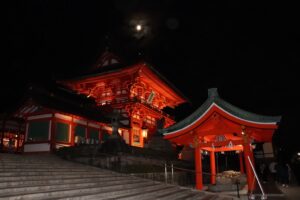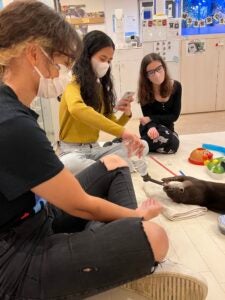
When I first arrived in Kyoto, Japan, two weeks ago, my hair stuck to my face anytime I went outside. Carrying groceries under the blazing heat of the sun felt like a momentous task, akin to that of the long walk up the hills of Austin to reach my dorm in the summertime.
Now as I write this, I’m wearing a long-sleeved shirt and jeans, letting the cool air from the balcony outside into my room. The speed at which nature has changed is jarring. After all, I’m used to just two seasons in Texas: hot summer and less hot summer!
Luckily, I’ve had the guidance of others to help me think through these changes.
On my first day of class at Kyoto University, my teacher gave a lesson on the importance of seasons in Japan. Unlike Texas, Japan’s seasons are very distinct, including a rainy season called tsuyu (つゆ, 梅雨). When I arrived in late September, the summer season was just ending, and Japan was slowly ushering in fall.

Within this lesson, my teacher also spoke a lot about the idea of kachoufugetsu (花鳥風月). This Japanese idiom translates to flower, bird, wind and moon, painting a picture in the listener’s mind through words alone and representing the cultural focus in Japan on the transient beauty of nature. This idiom is typically accompanied by the word mono no aware, or もののあわれ, the feeling that arises in a person when they’re faced with nature’s transience.
In class, my teacher passionately explained that since all things come to an end, we must cherish them that much more. He encouraged us to examine the small beauties of nature as autumn arrived in Kyoto.

Having lived in Texas for most of my life, or at least the parts I can remember, I am fascinated by the small changes Japan goes through each day. Trees I pass on my walk to and from the train station are slowly turning from shades of green to yellow and red. The red and white spider lilies that were in full bloom when I arrived are starting to fade, replaced with fragrant, bright orange Kinmokusei flowers. While walking down Nishiki market, sweet potatoes, chestnuts and pumpkin-flavored foods are at every stall.
Like my teacher said, I feel a warm ache in my chest when I am faced with the transience of this season, knowing I only have this chance to take in these small changes before they are gone, replaced by a new season to explore.
Greater than the changes I see outside every day, however, are the changes I find myself undergoing.
Funny enough, this became the clearest to me on my very first trip to the grocery store. I found myself steering my cart around in endless circles trying to find the items I came for. When I finally found them, I could only recognize a few characters printed on the label. I had to take the best guess at which item was exactly what I was looking for.
On top of this, I am used to eating “American food” every day, and I had no clue where to even start in learning Japanese cuisine. As someone used to making very simple meals at home, this was an incredibly daunting task!

These changes extend beyond grocery shopping to every aspect of my life.
I have been lucky enough to meet a variety of new people in all my classes. Sadly, my language ability only extends so far, and every conversation feels like a struggle on both ends. However, even within the short span of a week, I’m finding it easier to understand what people are saying and have been able to learn more about each of my new friends as we sightsee around Kyoto.
The slow progress I am making toward improving my Japanese makes me unbelievably excited for the day I can speak fully to my friends and truly get to know all about them.
It is so easy to get caught up in life — in the difficult process of learning a language, planning weekly meals or simply walking to the train station to get to school on time. I am not yet sure of the exact changes I will go through in Japan, but I am trying my best to slow down and appreciate the small things I experience every day. Hopefully, this way, I can keep that warm ache in my chest when faced with the transience of my time here in Japan and continue to explore the slow turning of each new season.
This post was contributed by Claire Wilson, a Global Ambassador for Fall 2022. Claire is a junior double majoring in international relations and global studies and Japanese language and culture, studying abroad in Kyoto, Japan.



Thank you for sharing this, Claire! It’s such a great reminder when we’re so used to instant gratification that there is beauty and meaning in moving slowly and in impermanence.